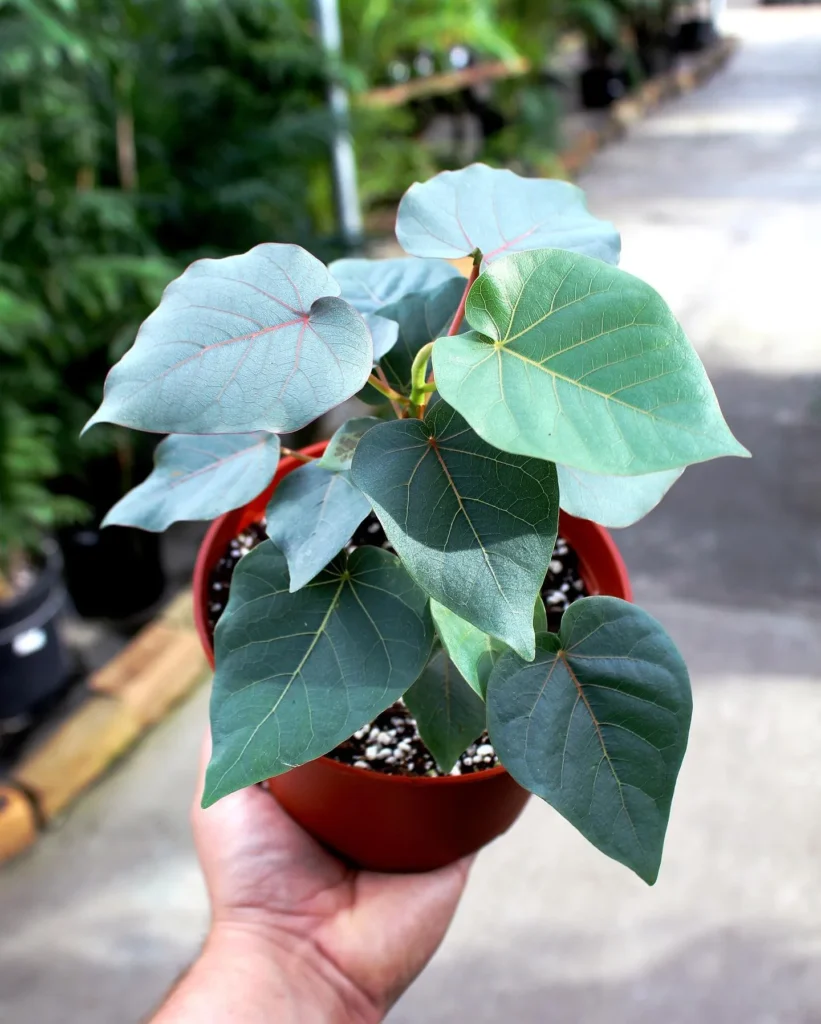Ficus watering plant when the top inch of the soil feels dry, using lukewarm water until it begins to drain from the bottom of the pot.
This comprehensive guide provides crucial watering tips for Ficus plant care, aiming to assist enthusiasts in maintaining their plants’ health. Covering everything from the right watering schedule to identifying signs of under or overwatering, it serves as a valuable resource for both experienced and novice indoor gardeners, offering the knowledge needed for thriving Ficus plants.
Understanding Ficus Plant Needs
Before we delve into effective watering tips for your Ficus plants, it’s crucial to have a good grasp of their specific needs. Understanding the natural habitat and water requirements of Ficus plants is a fundamental step towards ensuring their overall well-being and longevity.
Ficus plants are native to tropical climates, where they thrive in environments with high humidity and bright indirect sunlight. These plants prefer a consistent temperature between 60°F and 75°F (15°C and 24°C), making them suitable for indoor cultivation in most regions.
When it comes to water, Ficus plants have unique needs. They prefer consistent moisture but are sensitive to overwatering.
The key is to provide adequate hydration while allowing the soil to dry out slightly between waterings. This balance is crucial to prevent root rot and other water-related issues.
The signs of underwatering or overwatering in Ficus plants can vary. Dry, crisp leaves and leaf drop are common signs of underwatering, while yellowing leaves, wilting, and excessive leaf droop signal overwatering.
Knowing these indicators will help you adjust your watering practices accordingly and prevent potential damage.
To set the right foundation for successful Ficus care, it’s essential to familiarize yourself with these plant needs. Next, we’ll explore expert watering techniques to ensure your Ficus plants are healthy and thriving.
Finding the Right Watering Schedule
Establishing a suitable watering schedule is crucial for maintaining the health and vitality of your Ficus plants. By considering factors such as light levels, pot size, and environmental conditions, you can ensure that your Ficus receives the right amount of water at the right time.
First, let’s talk about light levels. Ficus plants prefer bright, indirect sunlight. This means they should be placed in a well-lit area away from direct sunlight, which can scorch their leaves. The intensity of light will impact the rate of water evaporation, so make sure to adjust your watering schedule accordingly.
The size of your pot also plays a role in determining the watering frequency. Smaller pots tend to dry out faster, requiring more frequent watering, while larger pots retain moisture for longer periods. Check the moisture level of the soil regularly to determine when your Ficus needs watering.
Establishing a Watering Schedule:
- Begin by watering your Ficus thoroughly until water comes out of the drainage holes.
- Allow the top inch of soil to dry out before watering again.
- Stick your finger into the soil to check for moisture. If it feels dry, it’s time to water.
- Keep a consistent watering schedule, but always adjust based on the plant’s needs and the environmental conditions.
Quality of Water for Ficus Plants
When it comes to caring for your Ficus plants, water quality is crucial. Using the right water can make a significant difference in their overall health and well-being.
Tap water, although convenient, may contain chemicals like chlorine and fluoride that can have adverse effects on your Ficus. These chemicals can accumulate in the soil over time, leading to nutrient imbalances and potential damage to the plant.
To ensure the best water quality for your Ficus, consider using alternative options. One popular choice is filtered water. Filtered water removes impurities and chemicals, ensuring a cleaner and safer water source for your plants.
Another option is to collect rainwater. Rainwater is naturally free of chemicals and rich in nutrients, making it an excellent choice for watering Ficus plants. Just be sure to collect rainwater in a clean container to avoid contamination.
Benefits of Using Filtered Water or Rainwater:
- Eliminates harmful chemicals found in tap water
- Prevents nutrient imbalances in the soil
- Promotes healthier growth and vibrant foliage
- Reduces the risk of plant damage and wilting
Watering Techniques for Ficus Plants
When it comes to watering your Ficus plants, it’s important to follow the right techniques to ensure their health and vitality.
Understanding the proper amount of water, as well as the method of watering and the significance of proper drainage, will contribute to the overall well-being of your Ficus plants.
1. Watering Amount:
The amount of water you give to your Ficus plants plays a crucial role in their growth. It is essential to strike a balance between underwatering and overwatering.
Give your Ficus plants enough water so that the soil is evenly moist, but avoid saturating or waterlogging the soil, which can lead to root rot.
2. Watering Method:
There are two common methods for watering Ficus plants – watering from above or watering from below.
- Watering from above: Using a watering can or hose, gently water the soil around the base of the plant. Ensure that the water reaches the root zone without splashing on the leaves. This method allows for better nutrient absorption.
- Watering from below: Place your Ficus plant in a container with water and let it soak up the water through the drainage holes. This method is particularly useful for plants with sensitive leaves that shouldn’t get wet.
3. Proper Drainage:
The importance of proper drainage cannot be overstated. Ficus plants thrive in well-draining soil as it prevents waterlogged roots and diseases.
Use pots with drainage holes and ensure that excess water can freely flow out. Additionally, make sure to remove any standing water from saucers to avoid water accumulation.
Signs of Underwatering and Overwatering
As a plant owner, it’s important to be able to recognize the signs of underwatering and overwatering in your Ficus plants. These signs can help you adjust your watering practices to ensure the health and well-being of your leafy companions.
Underwatering can be detrimental to your Ficus plants, causing them to become dehydrated and weak. Some common signs of underwatering include:
- Drooping leaves: When your Ficus plant lacks water, its leaves may start to sag or droop. This is a clear indication that it needs a good drink.
- Yellowing leaves: If the leaves of your Ficus are turning yellow and crispy, it may be a sign of underwatering. The lack of water prevents the plant from carrying out essential metabolic processes, resulting in leaf discoloration.
- Dry soil: Check the moisture level of the soil by sticking your finger about an inch deep. If it feels dry, your plant likely needs watering.
On the other hand, overwatering can be just as harmful to your Ficus plants. When you water your plants excessively, the roots can become waterlogged, leading to root rot. Look out for these signs of overwatering:
- Wilting leaves: Overwatering can cause the roots to suffocate, preventing them from absorbing oxygen properly. This can result in wilting and drooping leaves.
- Yellowing leaves: Similar to underwatering, overwatering can also cause the leaves to turn yellow. However, in this case, the leaves may feel wet or mushy.
- Foul odor: If you notice a foul smell coming from the soil or the plant itself, it could be a sign of root rot caused by overwatering. The excess moisture creates an ideal environment for harmful fungi and bacteria to thrive.
Watering During Different Seasons

As the seasons change, so do the watering needs of your Ficus plants. It’s essential to understand how environmental factors can impact water requirements throughout the year to ensure the health and vitality of your leafy friends.
During the summer months, when temperatures rise and humidity levels increase, Ficus plants tend to require more frequent watering. The combination of heat and dry air can cause the soil to dry out quickly, leading to dehydration and stress.
Keep a close eye on your Ficus and adjust your watering routine accordingly, ensuring that the soil remains consistently moist but not waterlogged.
In contrast, during the winter months, when temperatures drop and indoor heating becomes necessary, the air tends to become drier. This can result in a decrease in Ficus watering needs.
It’s important not to overwater your Ficus during this time, as the lower light levels and cooler temperatures slow down the plant’s growth and water uptake. Allow the soil to dry out slightly between waterings, ensuring proper drainage to prevent root rot.
Spring and fall are transitional seasons where you’ll need to closely monitor the changing weather conditions. Depending on your specific climate, you may need to adjust your watering schedule accordingly.
Factors such as rainfall, temperature fluctuations, and the amount of natural light will all affect the amount of water your Ficus plants require.
Takeaways:
- Summer: Increase watering frequency due to higher temperatures and humidity.
- Winter: Decrease watering frequency to avoid overwatering in drier indoor conditions.
- Spring and Fall: Monitor weather conditions and adjust watering accordingly.
Troubleshooting Common Watering Issues
Sometimes, despite your best efforts, issues may arise that affect the health and well-being of your Ficus plants. In this section, I will provide you with solutions to common watering problems that you may encounter.
1. Root Rot: One of the most common watering problems faced by Ficus plants is root rot. This occurs when the roots are constantly exposed to excess moisture, leading to their decay.
To prevent root rot, ensure proper drainage in your plant’s pot. Additionally, avoid overwatering and allow the soil to dry out slightly between waterings.
2. Yellowing Leaves: If you notice that the leaves of your Ficus plant are turning yellow, it could be a sign of overwatering. Excess water can cause the roots to suffocate, leading to nutrient deficiencies and discoloration of the leaves.
To address this issue, adjust your watering schedule and allow the soil to dry out more thoroughly before watering again.
3. Wilting: Wilting can occur due to both underwatering and overwatering. If your Ficus plant’s leaves are drooping and losing their turgidity, it may need more water.
Conversely, if the soil feels consistently wet and the leaves are wilting, it’s a sign of overwatering. Adjust your watering practices accordingly, ensuring the plant receives the right amount of water.
Summary and Additional Ficus Care Tips
Throughout this Ficus watering guide, we have covered essential tips and techniques to ensure the health and vitality of your Ficus plants. Now, let’s summarize the key information and explore some additional care tips to enhance your plant’s well-being.
To keep your Ficus plants thriving, remember to establish a suitable watering schedule based on factors like light levels, pot size, and environmental conditions.
By providing the right amount of water at the right time, you can prevent both underwatering and overwatering, which can lead to leaf drooping or root rot.
Water quality is another crucial aspect of Ficus care. Avoid using tap water that may contain chlorine or fluoride, as these chemicals can harm your plants. Instead, opt for filtered or distilled water to ensure optimal hydration for your Ficus.
Here are a few additional tips to take your Ficus care to the next level:
- Place your Ficus in a location with bright, indirect sunlight to promote healthy growth.
- Regularly wipe the leaves with a damp cloth to keep them clean and free from dust buildup.
- Consider using a well-draining potting mix to prevent waterlogging and root rot.
- During the growing season, apply a balanced, water-soluble fertilizer according to the package instructions.
By incorporating these additional care tips into your Ficus plant routine, you can create the perfect environment for your leafy friends to thrive and beautify your space.

















